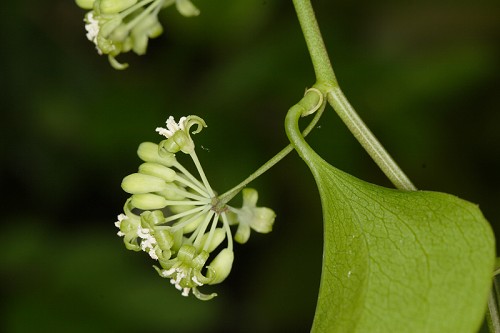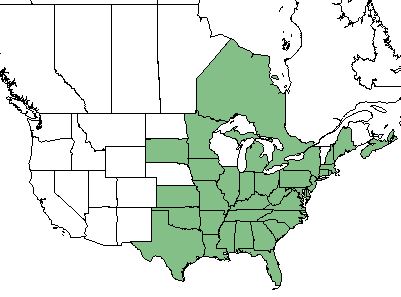Difference between revisions of "Smilax rotundifolia"
m |
|||
| Line 17: | Line 17: | ||
| range_map_caption = Natural range of ''Smilax rotundifolia'' from USDA NRCS [https://plants.usda.gov/core/profile?symbol=SMRO]. | | range_map_caption = Natural range of ''Smilax rotundifolia'' from USDA NRCS [https://plants.usda.gov/core/profile?symbol=SMRO]. | ||
}} | }} | ||
| − | Common Names: Common greenbriar; bullbriar; horsebriar<ref name="Weakley 2015">Weakley AS (2015) Flora of the Southern and Mid-Atlantic States. Chapel Hill, NC: University of North Carolina Herbarium.</ref> | + | Common Names: Common greenbriar; bullbriar; horsebriar;<ref name="Weakley 2015">Weakley AS (2015) Flora of the Southern and Mid-Atlantic States. Chapel Hill, NC: University of North Carolina Herbarium.</ref> roundleaf greenbrier<ref name="USDA">USDA NRCS (2016) The PLANTS Database (http://plants.usda.gov, 23 January 2018). National Plant Data Team, Greensboro, NC 27401-4901 USA.</ref> |
==Taxonomic Notes== | ==Taxonomic Notes== | ||
Revision as of 11:44, 23 January 2018
| Smilax rotundifolia | |
|---|---|

| |
| Photo by John Gwaltney hosted at Southeastern Flora.com | |
| Scientific classification | |
| Kingdom: | Plantae |
| Division: | Magnoliophyta - Flowering plants |
| Class: | Liliopsida - Moncots |
| Order: | Liliales |
| Family: | Smilacaceae |
| Genus: | Smilax |
| Species: | S. rotundifolia |
| Binomial name | |
| Smilax rotundifolia L. | |

| |
| Natural range of Smilax rotundifolia from USDA NRCS [1]. | |
Common Names: Common greenbriar; bullbriar; horsebriar;[1] roundleaf greenbrier[2]
Contents
Taxonomic Notes
Description
S. rotundifolia is a monoecious perennial that grows as a shrub or vine.[2]
Distribution
The distribution of S. rotundifolia ranges from eastern Texas, westward to northern Florida, and northward into the provinces of Nova Scotia and Ontario Canada.[1]
Ecology
Habitat
S. rotundifolia is found in a variety of upland and wetland habitats.[1]
Phenology
In the southeastern and mid-Atlantic United States, S. rotundifolia flowers from April through May with fruiting occurring in September through November and persisting beyond.[1]
Fire ecology
Controlled burns conducted during the spring of 2001 and 2004 in an Ohio mixed-oak hardwood forest had the fire spread at mean rates of 6.2-11.3 m min-1 (as cited in [3]). These burns significantly reduced the mean percent cover of S. rotundifolia from 10.9% in 2001 and 8.1% in 2004 to 0.7 and 1.1%, respectively. The combination of burn and winter thinning yielded similar results producing mean coverage of 0.7 and 1.9% for 2001 and 2004, respectively.[3]
Use by animals
Leave and twigs of S. rotundifolia are known to have been consumed by the Florida marsh rabbit (Sylvilagus palustris paludicola).[4]
Conservation and Management
Winter thinning in an Ohio mixed-oak hardwood forest reduced the mean percent coverage of S. rotundifolia from 10.9% to 3.1%. This reduced value was still higher than the reduction of cover produced by burning, suggesting burning to be more effective in reducing the coverage of S. rotundifolia.[3]
Cultivation and restoration
Photo Gallery
References and notes
- ↑ 1.0 1.1 1.2 1.3 Weakley AS (2015) Flora of the Southern and Mid-Atlantic States. Chapel Hill, NC: University of North Carolina Herbarium.
- ↑ 2.0 2.1 USDA NRCS (2016) The PLANTS Database (http://plants.usda.gov, 23 January 2018). National Plant Data Team, Greensboro, NC 27401-4901 USA.
- ↑ 3.0 3.1 3.2 Albrecht MA, McCarthy BC (2006) Effects of prescribed fire and thinning on tree recruitment patterns in central hardwood forests. Forest Ecology and Management 226:88-103.
- ↑ Blair WF (1936) The Florida marsh rabbit. Journal of Mammalogy 17(3):197-207.